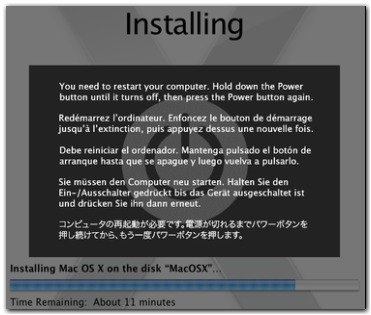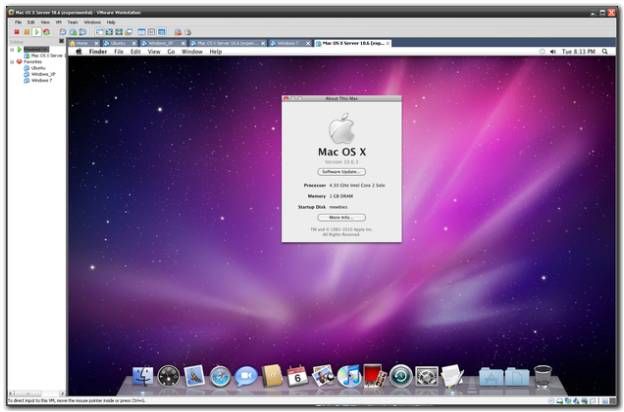
Snow Leopard Vmdk And Darwinsnow Iso File
It is full Bootable ISO Image of Niresh Mac OSX Yosemite for AMD & Intel. 6 Snow Leopard DVD (ISO or DMG for I used VMDK option to Opening a. A temporary VMDK which the VM Snow leopard vmdk and darwin snow iso For. Jul 14, 2014 Once all parts are downloaded and combined, burn it to a DVD using any software which creates and mount virtual CD/DVD ROMs; Run VMware and choose Open Existing VM or Team and browse to Mac OS X Server 10.6 (experimental).vmx file you downloaded in step 2; Now choose darwin_snow.iso (Must be in your C drive) as the CD/DVD (IDE) in the VMware options.
Super mario all stars wbfs software 2017. So I've got our old VMWare image from the old server. The image was sized for the old 36Gb SCSI drives and now resides on 160GB drives, and I need to resize. The D and E drives were dynamic disks that I could resize pretty easily by just expanding the disk through VMWare player and then Computer Management in the VM, but the C: is a Primary Partition and won't let me expand it. Is there a way to expand the virtual Primary partition to use the other 12GB of the VHD or do I have to drop the cash for one of the Partition Magic for Server varieties out there? I hate to spend that much money for something I'm only going to use once as next year we're going to be completely re-vamping our entire network and going from the 2k3 Enterprise VM to a 2k8R2 setup, this year is just a holdover. I wouldn't care so much about it, but the C drive was only set to 8GB and the last time we tried to do the Windows updates, we actually ran out of room on the drive (seriously, 0K free) and can't upddate things like the SQL server and such because of it.
Of course we need to update the SQL server so we can adapt and convert it to a newer version for the server re-vamp next year. Anyways, any ideas guys? Here's a screenshot of the issue: As you can see, we've only got 742 MB on C which isn't enough to run the Windows updates, much less anything else. Any suggestions guys? EDIT: The converter worked like a champ! Now I have some more general VMWare questions, and I didn't want to start a new thread.
Expanding non-boot basic disks is easy. Here's the trick I've used in the past to expand boot basic disks. Although I've only done this using SANs, it should work for you.
Shut down the VM using the c: drive. Take a snapshot of the drive in case something goes wrong. Let another server with the same OS see that drive. Expand the drive using diskpart if it's 2003 or disk management if it is 2008 or later. Take the drive away from that server.
Boot the VM back up. You should now have a larger C: drive. OK, more questions for y'all VMWare guru's. From my Mac Arcana post: Hey guys, I have a VM for VMWare Player running Snow Leopard that I used to run on my old machine. That machine was a C2D, 4GB RAM, etc, etc.
I tried running that same VM on my new machine and it crashed. From the searching I've done, it seems that the OS-X VM doesn't like my new AMD Phenom2 CPU.
Doing some searching around, I've found all sorts of people have the same problem, and about 2 dozen workarounds, and all of the workarounds seem to have problems. The most common one is using a Darwin-Snow-Legacy.ISO for it to boot from, but it seems that there's something missing. Has anyone set up something like this? I have the opportunity to borrow the Intel OS-X Lion or Snow Leopard disks for a few days and just create one from scratch, but as far as I know I can't just create a new VM, point it to the Lion disk, and away I go because of the CPU/chipset/GPU combo I have.
Is there a walk-through somewhere that actually works? What do the.ISO images actually do? Which one will I actually need? Other questions: 1: What is a VMWare appliance? I see there are some.nux OS appliances which appear to be pre-compiled installs of the full OS and it's apps. Is that correct? What are the other appliances and what is an Appliance used for?
Not specific appliances, but in a general 'appliances are tools that have been built in as images' or 'appliances are add-on packs that go in through VMW Player' or something. 2: When I move a VM from machine to machine I always get the 'Is this copied or moved?' Question when I fire it up.
Aren't the VM's universal? 3: The VMWare Server has been EOL'd at 2.0.2, which sucks.
Is there a free replacement that does the same thing or do I really need to purchase a vSphere setup? Where does ESXi come into all this? I don't see it on their page, but we need something that will work in more modern versions of.nux for a small non-profit I work with. 4: The VMWare converter worked well for adjusting the HDD size, but I haven't had the chance to really dig into it. Can and how well does it do converting VMWare to Hyper-V? Has anyone here done it? Is it really ugly?
5: All I can find on the interwebs is sales propaganda, but basically what I see is that Hyper-V is better than VMWare, VMWare is better than Hyper-V, and it seems that the only things I can find for each of them is that Hyper-V seems to support newer hardware better (if it works in Win, etc.) and it's free, whereas the big selling point to VMWare is that it's been around so long, it's less prone to buggy. What else am I missing? I've read the comparisons between MS and VMWare, but it seems to be all marketing speak about how their product is better than their competitor. What are y'alls personal expierences? 6: 4GB of RAM seems to be the sweet spot for most modern OS's. If I have 8GB of RAM, should I only try to run 2 VM's at a time, and if I were to throw in 16GB, would that make it 4VM's plus host?
Mount & Blade Warband Mods WSE (Warband Script Enhancer) For Latest Warband WSE (Warband Script Enhancer) For Latest Warband In by Pinhan Pain June 16, 2017 Leave a Comment. Mount and blade warband wse 1153 download pc. Download the latest version of Warband Script Enhancer from this page; it should be the first link under the 'Downloads' section for Warband 1.153. Find where you have downloaded the file to. It should be named something like ' WSE v3.1.3.zip ' or something similar if it is a version newer than that. Mount & Blade: Warband. Hello, in this guide, ill show you where to download the latest WSE version (4.2.5) for 1.168 version of Warband and how to install it.
Or is there scaling tricks? I'm thinking that at that point my biggest bottlenecks to performance is the fact that all the VM's run off the same 5400RPM SATA drive.
Is that the correct line of thinking? No, I can't change or add drives or SSD's. OK guys, I think that's enough brain picking for the moment.
I'm just trying to learn this stuff in a hurry because I've been having to work with it (got dropped in my lap) and I'm getting tired of telling everyone I'm a Hardware Gorilla, not a Code Monkey or a Sysop Simian. 1: Appliances are pre-built VMs configured for a specific purpose that you can drop into your network. 2: Not sure, I've not seen that dialog. 3: VMWare and MS both offer free hyper-visors. ESXi is free.
Hyper-V Server is free. You start paying when you want centralized management, failover, vMotion, etc. 4: vCenter converter doesn't do VMWare to Hyper-V. If you have SCVMM for Hyper-V however, you can do converts to Hyper-V with that.
5: ESXi vs Hyper-V: I've used both in production environments, and they both do the job. ESXi has more mature management tools.
The biggest beef I have with Hyper-V is the network configuration; it's retarded. ESXi is a fair bit simpler and clearer in this respect. Hyper-V does have an edge with supported equipment; if there is a Windows driver for it, it's likely to work. ESXi has a much more restrictive HW list.

6: That drive is going to hurt your performance. ESXi allows you to over-subscribe your memory. Hyper-V does not (and no, dynamic memory in SP1 doesn't allow this). Generally both hypervisors reserver about 512MB for the host, but it's configurable. You can slice up the memory however you want, 4 VMs with 4, or 8 VMs with 2, or a mix of any amount, within the host limitations.